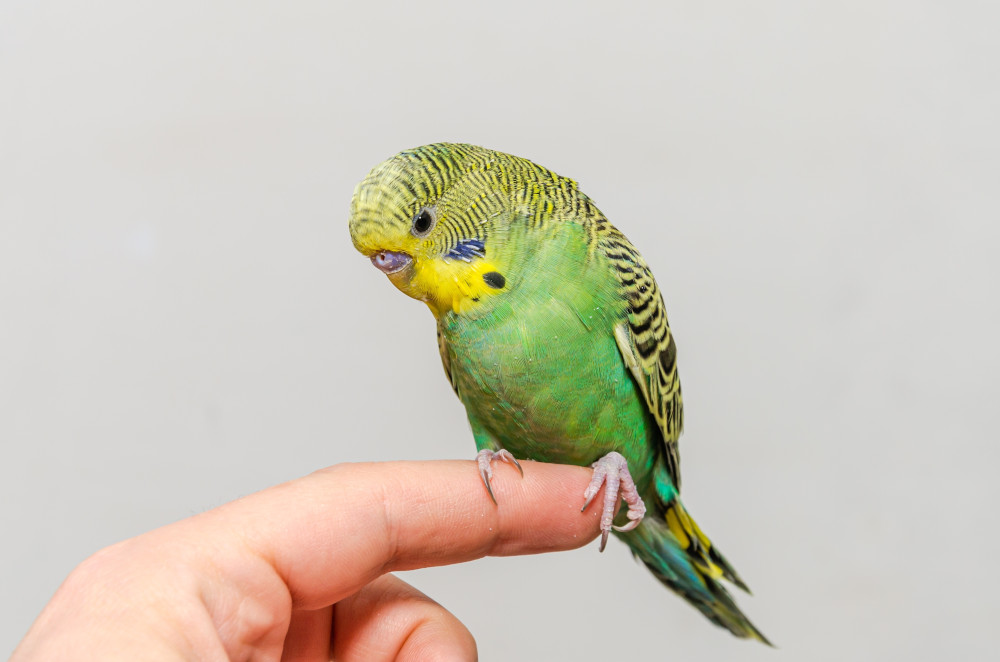How should I handle my bird?

At some time, you, the owner, must handle (and sometimes restrain), your bird. Traditionally, it was considered acceptable to put on a heavy pair of gloves, pin the bird to the tabletop or the side of the cage and then drag them, struggling and screaming, into a position where the bird could be restrained. Undoubtedly this stress contributed to the myth that birds were ‘soft’ animals, prone to dying while just being handled!
Just as it is inappropriate to muzzle and grapple with every dog and cat that comes into a veterinary surgery, it is inappropriate to use heavy-handed restraint on a companion bird. Many of these birds have learnt to trust humans and regard them affectionately. Destroying this trust through aggressive catching and handling techniques can adversely affect the bond between owner and bird. This relationship must be preserved and handling techniques for closely bonded birds should emphasize minimal stress and fear. No form of restraint should ever be taken lightly, as each restraint has some effect on the behaviour, life, or other activities of the bird.
The restraint mantra
All pet owners should be aware of, and practise, the following mantra that leads to success in animal handling:
- There is strength in gentleness: If you have to use force when handling your bird, you are doing it the wrong way. Stop, and re-think your approach. How can you do this without forcing your bird do as you want?
- Good restraint is about empathy, finesse, and technique: Understanding your bird, putting yourself in their shoes (so to speak) and reading their body language will help you to understand what your bird is feeling and what they are likely to do next. Using confident, practised low stress techniques will impart confidence to both you and your bird. You don’t have to use brute force!
- Preparation is equally important as execution: Have everything ready before you start – ‘walk through’ what you are intending to do and have make sure that anything or anyone you need is available and working.
Training your bird to accept handling
An important change in how we think about bird behaviours was changing our thoughts about the concept of dominance. It was long thought that a strict hierarchical structure existed within bird flocks, with dominance being reflected in advantages such as the highest perch, the best food and first choice when selecting a mate. It was further thought that in a human–bird ‘flock’ situation, a similar dominance had to be maintained, with the human, at all times, being the dominant member of the ‘flock’.
However, studies of wild birds have shown that dominance, while it does occur, is not at all strict; rather, it is a fluid arrangement with different birds being dominant at different times. A flock is inconsistent in its structures: members are lost to predators, family groups change between flocks, new members are constantly being added. This makes a straight-line hierarchy difficult to maintain, and too energy demanding to be compatible with survival in the wild. Therefore, the rigid dominance so often seen in human society does not readily transfer over to the bird world, and attempts to impose it usually involve ‘flooding’ a bird (overwhelming the bird with an imposed behaviour until the bird ‘just gives up’) or using negative reinforcements and punishment as means of instilling discipline. The problem with these techniques is that the bird learns to perform a behaviour, or avoid exhibiting one, just enough to escape adverse consequences. Once these consequences are removed, the behaviour returns.
What we know now is that the best results are obtained when a bird wants to do the behaviour that the owner desires, through the use of positive reinforcement.
Positive reinforcement involves providing a favourable consequence (or reward) for a behaviour. This increases the likelihood that the bird will repeat the behaviour in the expectation of the reward. The motivation used to stimulate a desired behaviour must be evaluated from the bird’s perspective, and this can be influenced by several factors:
- The relationship between the bird and the person. This relationship must be built on trust, respect, and prior positive experiences. Good communication must exist between the two: both must understand the other’s body language to know what they want.
- The bird’s confidence and ability to perform the behaviour.
- The bird’s past experiences in training and motivation.
- Natural influences such as social interaction, breeding season, comfort, and height.
- The bird’s hunger state or preference for certain feed items.
Some examples of good motivators include favourite food items, praise, and petting, proximity to people, a familiar object and even out-of-cage time.
Negative reinforcement, on the other hand, involves applying an unpleasant consequence to a behaviour in the expectation that the bird will cease the behaviour to avoid the consequence. Examples of this include shouting at the bird, giving the bird ‘time out’, covering a cage or squirting the bird with a water pistol. The problem with negative reinforcement is that the bird will do only just enough to avoid the consequence, and no more. In fact, as soon as the consequence is removed, the behaviour usually returns. Undesired consequences of negative reinforcement can include escape/avoidance behaviour, aggression, apathy (a decreased responsiveness in behaviour), and fear, leading to phobic behaviour.
How do I teach my bird to step up?
Stepping up is an early behaviour that can take 90% of the stress out of handling your bird.
The key elements here are breaking the behaviour down into a series of small steps (approximations) and then rewarding your bird each time they perform the approximation. Once each approximation is learned, you move onto the next. Eventually all the steps, when joined together, lead up to the final desired behaviour – willingly stepping up on your hand.
The steps can look something like this:
- You hold your hand up in front of your bird, offering it a treat (usually a favourite food). As soon as it leans towards the food, you reward your bird with the treat. Once it has mastered this, you move on.
- This next step has you holding the food up (as before) with your other hand flat (palm down) between you and your bird. This time you hold the reward further away from the bird so they have to lean right out. As soon as they lift their foot and place it on your hand, the reward is given. When your bird consistently places a foot on your hand, you move on to the next step. If your bird refuses to do this, go back to the previous step and start again.
- Repeat Step 2 but with the reward even further back – now your bird has to step up on your hand with both feet to receive the reward.
- Now introduce a cue – saying “Step Up” as you hold your hand and the treat up. As your bird starts to step up on to your hand, praise them and give the reward. Eventually the goal may be to phase out (or reduce) the reward to encourage the performance of the behaviour on the cue.
Although this sounds quite complicated, most birds can master “Step Up” in 5-10 minutes!
Bibliography
Doneley B (2018) Avian Medicine and Surgery in Practice: Companion and Aviary Birds, 2nd ed. CRC Press
RSPCA Australia believes that captive-bred wild animals should not be kept in a home environment or for companion purposes unless the species has been clearly identified as being suitable for this purpose. It is important that animals living in a home environment can live a good life. This means providing for their physical health and ensuring opportunities to fully express their individual interests and experience good welfare. Inadequate care and husbandry are reported to contribute to common and serious welfare compromises in many captive wild animals living in home environments. For more information see our policy.
The reality is, however, that captive-bred wild animals are kept in home environments despite sometimes not meeting these criteria (e.g., some reptile and bird species). Because of this, the RSPCA has produced these articles on the care and welfare of a variety of commonly kept captive-bred wild animals. The aim is to help people better understand their animals as individuals and provide them with care that keeps them healthy and provides opportunities for positive mental experiences as much as possible in captivity.
Wild animals must not be taken from the wild to be kept as companion animals (pets).
Was this article helpful?
This work is licensed under a Creative Commons Attribution-NonCommercial-NoDerivatives 4.0 International License.



